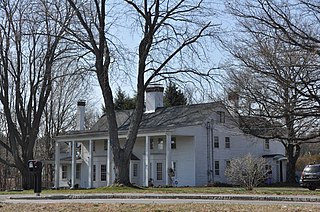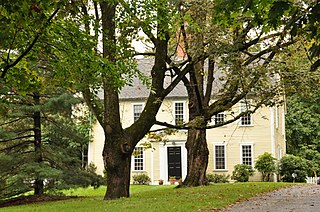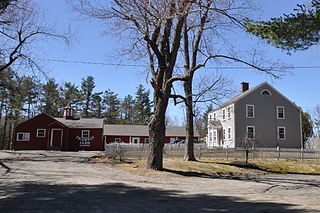
Naumkeag is the former country estate of noted New York City lawyer Joseph Hodges Choate and Caroline Dutcher Sterling Choate, located at 5 Prospect Hill Road, Stockbridge, Massachusetts. The estate's centerpiece is a 44-room, Shingle Style country house designed principally by Stanford White of McKim, Mead & White, and constructed in 1885 and 1886.

The Kidder–Sargent–McCrehan House, also known as the Kidder–Sargent House, is an historic house in Cambridge, Massachusetts. The 2.5-story wood-frame house was built c. 1792 by Nathaniel Kidder, and is one of the oldest and least-altered buildings of the period in northwest Cambridge, and the only one on its original site. The house follows a typical Georgian center-chimney plan, with two rooms on either side of the chimney on each floor. The house was sold out of the Kidder family to Solomon Sargent in 1835, and was acquired by Jeremiah McCrehan in 1876.

The Abbot-Stinson House is a historic house in Andover, Massachusetts. The house is estimated to have been built in the early 1720s, in the transitional period between First Period and Georgian styles of construction. It was originally one room deep with a central chimney, but was extended by additions to the rear in the 20th century. The house was listed on the National Register of Historic Places in 1990.

The Philemon Sage House is a historic house at 69 Sandy Brook Turnpike in Sandisfield, Massachusetts. Built in 1799 and enlarged in 1827, it is a good local example of Federal period architecture. It was listed on the National Register of Historic Places in 1982.

The Dickinson–Pillsbury–Witham House is a historic First Period house which, along with an 18th-century barn, sits on an 8.84 acre lot in Georgetown, Massachusetts. The well-preserved building with its massive original hardwood frame has many surviving early components, including a rare original enclosed stairway, doors, wooden latches, hardware, cupboards, brick nogging in the walls, and early paint.

The House on Labor-in-Vain Road is a historic house in Ipswich, Massachusetts. Built about 1720 and enlarged c. 1810, it has a well-preserved assortment of architectural stylistic details predating 1850. It was listed on the National Register of Historic Places in 1990.

The Platts-Bradstreet House, is a historic house museum at 233 Main Street in Rowley, Massachusetts. Its oldest portion dating to about 1677, it is a well-preserved example of First Period architecture, modified by repeated addition during the 18th century. The house has belonged to the Rowley Historical Society since the 1920s. It was listed on the National Register of Historic Places in 1980.

The Sawyer House is a historic First Period house in Boxford, Massachusetts. It is a 2+1⁄2-story central-chimney house with an attached rear two-story wing. A two-story full-width portico supported by seven turned columns shelters the front of the house. Like many First Period houses, this one was built in stages, and exhibits a variety of architectural styles despite its early origins. The first portion to be built was the center chimney and the two-story section to its right, in c. 1700. Later in the First Period the rooms to the left of the chimney were added. The rear wing was added in the 19th century, as was the front portico. There two further additions in the 20th century, including a sun room at the rear where the 19th-century addition meets the main house, and single-story shed-roofed addition on the west gable end, running the full depth of the house.

The Rev. Samuel Woodward House is a historic house located at 19 Concord Road in Weston, Massachusetts. Built in 1753, it is a well-preserved example of mid-18th century Georgian architecture. It has also been home to a succession of people significant to the history of the town. It was listed on the National Register of Historic Places in 1976, and was included in Weston's Boston Post Road Historic District in 1983.

The McKenna Cottage is a historic house on Windmill Hill Road in Dublin, New Hampshire. It was originally built about 1889 as a single-story wing of the nearby Stonehenge estate house. It is a good example of Shingle style architecture, and one of the town's surviving reminders of the turn-of-the-century summer estate period. The house was listed on the National Register of Historic Places in 1983.

The Asa Morse Farm, also known as the Friendly Farm, is a historic farmstead on New Hampshire Route 101 in Dublin, New Hampshire. The main farmhouse, built in 1926 on the foundations of an early 19th-century house, is a good example of Colonial Revival architecture, built during Dublin's heyday as a summer retreat. The farmstead was listed on the National Register of Historic Places in 1983.

The Hart-Rice House is a historic house at 408 The Hill in Portsmouth, New Hampshire. It is located on The Hill, a cluster of closely spaced historic buildings southeast of Deer Street, some of which were moved to the site as part of a road widening project. Built sometime between 1749 and 1756, it is a little-altered example of Georgian architecture with only modest Federal period alterations. It was listed on the National Register of Historic Places in 1972.

The Deacon Samuel and Jabez Lane Homestead is a historic farmstead at 132 Portsmouth Avenue in Stratham, New Hampshire. Built in 1807, the main house is a fine local example of Federal period architecture, with carvings executed by a regional master craftsman. The property is further significant because the owners at the time of its construction kept detailed journals documenting the construction of it and other buildings on the property. The property was listed on the National Register of Historic Places in 1983.

The Nutting Homestead is a historic farm complex on Maine State Route 121, south of the center of Otisfield, Maine. The property has been owned by the Nutting family and its descendants since the late 18th century and exemplifies the adaptive use of farm properties over time. The oldest portion of the farmhouse dates to 1796, and other buildings in the complex date mainly to the 19th century. The property was listed on the National Register of Historic Places in 1974.

Perciphull Campbell House is a historic home located near Union Grove in Iredell County, North Carolina. The house was built about 1820 by Perciphull Campbell and is a two-story, frame I-house dwelling. It has a gable roof, stone foundation, and exterior chimneys with stuccoed brick stacks. Also on the property is the contributing smokehouse.

The Barnes-Hill House is a historic house at 12 North Brookfield Road in Spencer, Massachusetts. Built about 1800, it is a well-preserved local example of Federal architecture, and was home to figures influential in the development of the Hillsville area where it stands. The house was listed on the National Register of Historic Places in 2016.

The Sargent-Robinson House is a historic house in Gloucester, Massachusetts. Built about 1760, it is a well-preserved example of an iconic local form, the gambrel-roofed cottage. It also includes probable foundational remnants of the c. 1700 house built on the site, and was owned into the 20th century by descendants of Samuel Sargent, who settled the land in 1695. It was listed on the National Register of Historic Places in 2016.

Margarett Williams Sargent was a noted painter in the Ashcan School and a follower of George Luks. She exhibited as Margarett Sargent and Margarett W. McKean.
The Maple Hill Farm is a historic farm property at 65 Maple Hill Road in Norwich, Vermont. Encompassing more than 40 acres (16 ha) of woodlands and pasture, the farm has more than 200 years of architectural history, including a late 18th-century farmhouse built by Peter Olcott, and two barns from that period. It remained an active farm property until 1966. The property was listed on the National Register of Historic Places in 2020.






















